

Click map to see detailed route


Click map to see detailed route
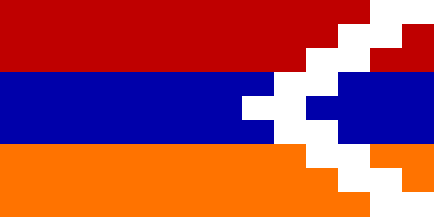
27 August Stepanakert (Nagorno Karabakh)
Journey To a Rebel Republic
I got up early and set off for the bus station where I found a car fetching people to NKR. It was cheaper to take the bus there but I supposed a private car would do it cheaper, and in any case, a shared car wasn’t too expensive (I paid US$20). An interesting observation: while most domestic buses were labeled in Armenian, buses to Stepanakert, the NKR capital, were labeled in Russian (smile – easy for tourists to read), for the Karabakhis have been so Russified during Soviet rule that they still speak more Russian than Armenian.
Looking at the people around me, they appeared pretty Middle Eastern and to a certain extent Mediterranean. This country has been lumped together with Russia for so long that many people still, to the annoyance of locals, call the entire region “Russia”. Instead of finding blonde, fair-skinned people, one meets all these attractive black haired angels with sharp eyebrows and wide smiles. So different from their Georgian Christian neighbours to the north.
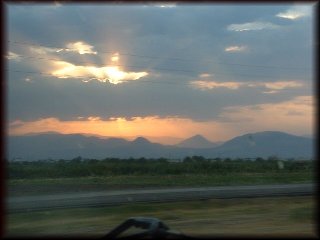 It was a bright sunny day as we sped southwards along the Turkish-Armenian
border. In these foothills of the towering, snowcapped Mt Ararat,
where Noah was supposed to have landed his ark. American and Russian
watchtowers equipped with satellite dishes spy on each other on what used
to be the most sensitive border on the East and West. Beneath the surface,
older animosities were at play. Before 1915, the land west of this
border was known as western Armenia but in that year, the Ottoman Turks
carried out a systematic massacre of 1.5m Armenians, an event that the
Armenians never forget and the Turks never admitted to this day.
Instead they talk about the “genocide of the Eastern Anatolian Turks”,
alleged committed by the Christian forces.
It was a bright sunny day as we sped southwards along the Turkish-Armenian
border. In these foothills of the towering, snowcapped Mt Ararat,
where Noah was supposed to have landed his ark. American and Russian
watchtowers equipped with satellite dishes spy on each other on what used
to be the most sensitive border on the East and West. Beneath the surface,
older animosities were at play. Before 1915, the land west of this
border was known as western Armenia but in that year, the Ottoman Turks
carried out a systematic massacre of 1.5m Armenians, an event that the
Armenians never forget and the Turks never admitted to this day.
Instead they talk about the “genocide of the Eastern Anatolian Turks”,
alleged committed by the Christian forces.
Asked what my name was, I said “Cheng” (keep it simple – BUT don’t call me that!), and my fellow travel passengers said, “Jackie Chan ?” We had a good laugh. On my travels I have often been asked whether I knew kong fu, karate, or any of the Far Eastern martial arts. It’s a difficult question. If I say no, will these people try rob me – forgive my cynical self – I do get paranoid when dodgy looking young men asked me such questions. If I were to give a positive answer, I might be asked to provide a demonstration. How should I react then ?
When my fellow passengers pointed at Mt Ararat - the symbol of their nation which today lies on the Turkish side of the border - I said "starri Hayastan" - "starri" being "old" in Russian and "Hayastan" being Armenia in Armenian. This prompted much joy and applause from my fellow travellers, all of whom are Karabakh Armenians. My driver showed me a photo from his drawer - him in military uniform together with other young fedalyis (Armenian freedom fighters).
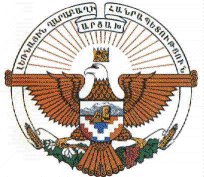 Nagorno Karabakh
(NK) is a mountainous enclave totally surrounded by Azerbaijan. Its
population of 150,000 was mostly Armenian (now it is almost exclusively
Armenian) but Stalin's divide and rule policy allocated the territory to
Azerbaijan in the 1920s. In 1989, protests against Azeri discrimination
against Karabakh Armenians led to a declaration of independence from Azerbaijan.
This, together with anti-Armenian pogroms in Sumgait and other parts of
Azerbaijan and a Soviet-supported clearing of Armenians in NKR, sparked
off fighting that only ended in 1994, by which time more than 30,000 were
dead. The Armenians had defeated Azerbaijan, not only taken over
4,000 sq km of NKR land but also 14,000 sq km or 14% of Azerbaijan proper,
with 1 million Azeri civilians turned into refugees in their own country.
By the way, Azeris claimed 20% of their country was occupied – I wonder
about but am not surprised about the discrepancy of the rival claims.
Nagorno Karabakh
(NK) is a mountainous enclave totally surrounded by Azerbaijan. Its
population of 150,000 was mostly Armenian (now it is almost exclusively
Armenian) but Stalin's divide and rule policy allocated the territory to
Azerbaijan in the 1920s. In 1989, protests against Azeri discrimination
against Karabakh Armenians led to a declaration of independence from Azerbaijan.
This, together with anti-Armenian pogroms in Sumgait and other parts of
Azerbaijan and a Soviet-supported clearing of Armenians in NKR, sparked
off fighting that only ended in 1994, by which time more than 30,000 were
dead. The Armenians had defeated Azerbaijan, not only taken over
4,000 sq km of NKR land but also 14,000 sq km or 14% of Azerbaijan proper,
with 1 million Azeri civilians turned into refugees in their own country.
By the way, Azeris claimed 20% of their country was occupied – I wonder
about but am not surprised about the discrepancy of the rival claims.
To the besieged and subsequently victorious NK Armenians, the 2.5m Armenians in the Republic of Armenia and the 6m strong diaspora worldwide, this generated a sense of great pride - it's the first time in the past 500 years that the Armenians have gained territory rather than lost more ground.
Within an hour, the car left the fertile valley of the Ararat and entered
a wild desert like area, with moonscape-like mountains and yes, still lots
of watch towers. Here we have left the border with Turkey, and instead
faced the borders with Azerbaijan’s Naxcivan (Sometimes spelled as Nakhchivan)
enclave. Separated from Azerbaijan proper, Naxcivan was artificially
created by Stalin to provide Azerbaijan with a common border with
its Turkish ethnic cousins, although this common border was only 20km or
so long, and for 60 years, there were no roads across the Arax River between
the two countries. Once again, this was the result of great power
politics in which Kemal Mustafa Ataturk, father of modern Turkey agreed
with Lenin the policy of mutual non-interference, thus abandoning an earlier
failed attempt by the Young Turks junta to set up a pan-Turkic empire in
the Caucasus and Central Asia, in exchange for peace on common borders.
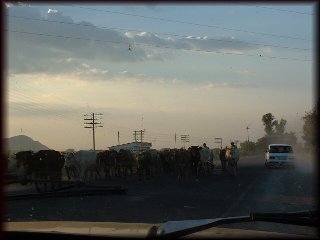 |
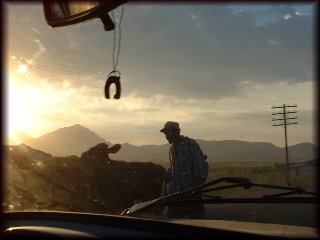 |
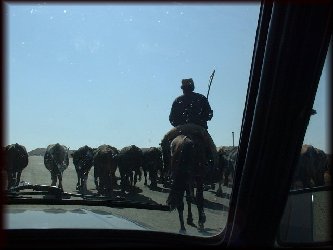 |
|
|
If one speak to any Armenian, they would tell you that Naxcivan was once Armenian but now depopulated of Armenians. The world’s largest collection of khachkars, or ancient Armenian crosses, lie in Jugha, within Naxcivan, and was supposedly destroyed by the Azeris in recent years to wipe off all traces of Armenian presence in Naxcivan. On the other hand, the Azeris would say Naxcivan has always been Azeri, and that the Armenian province of Siounik, previously known as Zangezur and now squeezed between Naxcivan and the internationally-recognised boundaries of Azerbaijan proper, used to be Azeri and was handled to the Armenians by Stalin. Who’s right and who’s wrong ? The history of the Caucasus, even right down to the basic facts and figures, or chronology of events, have always been in dispute. Everybody has their own version of rights and wrongs, plus their own maps of “what our country should be”, and you can be certain that that map probably shows their country at three or four times its current size, with wide expense of “unliberated territories” around them.
Whatever are the facts, from what I have read, the Naxcivan Autonomous Republic (the Soviets were fond of mini autonomous states everywhere and most of these continued to be pseudo-autonomous with the downfall of the USSR) is an interesting region to visit. It has numerous ancient Seljuk Turk and Arab monuments. For a small territory with only 350,00 people, Naxcivan has produced many great Azeri leaders, including Abulfaz Elchibey, the first elected president of Azerbaijan, and Heydar Aliyev, long-time Soviet era leader, Soviet Politburo leader and then currently president of Azerbaijan, after he overthrew Elchibey. And yes, the Naxcivan Autonomous Soviet Socialist Republic was the first territory to declare independence from the USSR, in 1991, upstaging even Lithuania, only to rejoin Azerbaijan 2 weeks later (Mark Elliot’s Azerbaijan with Georgia).
Well, back to my journey – the car sped along what has now become a treacherous winding road through the mountains. A lady passenger couldn’t quite take the shock and we had to stop a few times for her to vomit. This was a desolate region with few inhabitants and the only other people we encountered were occasional shepherds and intercontinental trucks from Iran. It was amazing that northern Armenia was connected to the south only via a dusty, deteriorating double lane road. I was assured that the roads used to be much worse, and one could imagine how tough the journey was when volunteers in the north rushed south during the Karabakh war. And of course, how useful it would have been if the Armenians had captured Naxcivan and thus securing their access to the south. I was told that the Armenians had been warned against such a move, for it would mean Turkey’s invasion of tiny Armenia.
This was the Province of Siounik, a beautiful land of untouched wilderness.
This was also the land of the fedalyis, young nationalist Armenians who
would not hesitate to take up arms against foreign invaders (and of course,
teach conscription-evasive softies in Yerevan who’s meant by a true Armenian).
During the advance of the Red Army which ended the first Armenian Republic
in 1922, it was in Siounik that the last Armenian fedalyis put down their
arms, and that only after some cunning lies and fake promises from the
Soviet High Command. During the weeks shortly before my visit, rumours
circulated about secret peace agreements between Armenia and Azerbaijan
which provide for the transfer of the Megri corridor (in southern Siounik
on the border with Iran, which protested about such intentions, for it
would cut off Iran’s bridge to Europe) between Azerbaijan proper and Naxcivan,
in exchange for Azeri recognition of Armenian control over NKR. No
way, my Armenian friends said, unless the president was willing to risk
being assassinated. And in any case, the veterans of Siounik would
rise up and defend Megri.
Nagorno-Karabakh: Promised Land for Some, Destroyed Dreams for Others
Hours later, as we approached the old border between Armenia and Azerbaijan, the desert-like landscape transformed into green rolling hills with deep forests. This is the Artsakh, another name for NKR, a New Jerusalem of the Armenians, many of whom have described it as a beautiful paradise. Here the pot-holed lanes that define much of the roads in the Caucasus are now a new 2-lane highway complete with crash barriers, fresh paints and street lights - all these financed by the Armenian diaspora, especially those from Los Angeles USA, France and Argentina. Of course, in true Caucasian style, not all the money went where they should go - rumours say that the 64km highway is 20 cm narrower than it should be... the money must have gone into someone's new house in the French Riviera or Cyprus.
The first signs of war here were the burnt Azeri towns one passes on
the way to Stepanakert, capital of the Nagorno-Karabakh Republic, a statelet
with its own flag, president, stamps and army. The strategic Azeri
town of Lachin which lies between Armenia and NK is now renamed Berdzor
and resettled with Armenians, although destroyed houses and roofless buildings
remain more common than inhabited ones. After all, 1 million Azeris
have become refugees for the freedom of 150,000 Karabakhi Armenians.
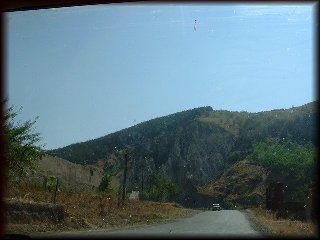 |
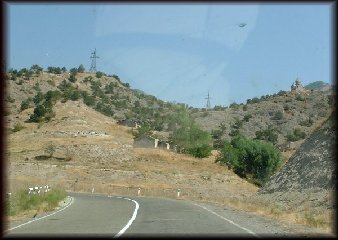 |
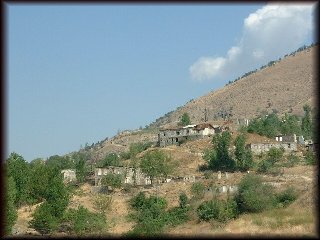 |
|
|
Something interesting about Lachin – between 1923 and 1929, it was the capital of the short-lived Kurd Autonomous Province, or “Red Kurdistan”. Many Kurds used to live here and in Kelbajar, which lies further north, also a district of Azerbaijan proper occupied by the Armenians. They, too, were displaced alongside their Azeri neighbours when the Armenians advanced. In the spirit of cooperation with the Armenians against Turks and their Azeri ethnic cousins, the Kurdish Workers Party (PKK) guerrilla movement actually abandoned their fellow Kurds, refusing to condemn Armenian ethnic cleansing in Lachin and Kelbajar. Apparently, the Yezidi Kurds in Armenia even fought here (for Armenia) for the capture of Lachin and Kelbajar.
We soon entered NKR – there were neither signposts nor border posts indicating a separate country. Suddenly there was a checkpoint and two policemen with the wing-spread eagle emblem of NKR checked the car. They had a conversation with the car driver, some loud grumbling, and a quick trip to the post. The driver was probably forced by corrupt police to pay a bribe before being allowed to continue the journey.
OK, let’s play that famous Caucasus game – “Who got here first ?” The Armenians claim that they were first, with evidence such as DNA tests of an ancient stone-age skeleton found in NKR (which supposedly proved that she is related to the Armenians of today – oh sure, the Armenian nation has existed since Stone Age – I suppose if you check DNA structure of Britons and even Bushmen of the Kalahari you may find some similarities), and the presence of Armenian monasteries and khachars in NKR (better arguments. Indeed NKR is full of great Armenian monuments dating back to the 7th Century. Pity that I didn’t have time for them). But the Azeris has their own evidence too – they claimed to be the descendants of the Turkic tribes and heir of the ancient Caucasian Albanians, an ancient people (not related to the Balkan Albanians) who have lived here and built great monuments. And that the Armenians here are actually Christian Albanians and hence Christian Azeris! The interesting question here is, what if these supposedly “Christian Azeris” decided to declare independence from Azerbaijan… A more acceptable Azeri stand is that this territory has been the centre of old Azeri and Persian khanates, which was true, and does has strong Azeri character, which is undeniable. These arguments and counter-arguments, all lead one to a conclusion, both Armenians and Azeris have always lived here, and both nations should jolly well decide how to settle the problem if they want to move forward and live in peace.
By the time we reached Stepanakert (the Azeris called it Xanxandi), the driver and one of the passengers have already invited me to stay at their homes. I had to turn down these friendly Karabakhis as I have already accepted an offer from my friend H., whom I was introduced by the NKR Mission in Yerevan. I rang H. but he wasn't around. His friendly flatmate, A., got his boss, a NKR Cabinet Minister, to drive me around instead. The Minister, a tall young man in his early 30's ( - I was told that NKR ministers are mostly young because the War forced responsibilities on the young), turned up in his Volga, the usual Soviet car for dignitaries. And I was given a quick tour of Stepanakert's main sights. The city, named after a Bolshevik leader in the Baku Commune, was almost totally destroyed during the war - bombs rained on the city from Shushi (known to the Azeris as Shusha), an ancient city located on the hills above Stepanakert. Since then, diaspora money has rebuilt it, turning it into perhaps the most orderly capital in the Caucasus.
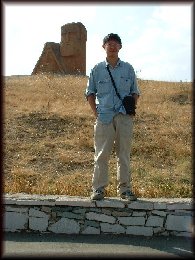
Me in front of the national symbol of Karabakh - "Grandpa and Grandma"
Despite its apparent peacefulness, Stepanakert remains a sleepy little
town with little economic activity. NKR, despite its own stamps,
flag and other symbols of a supposedly independent state, has to rely on
subsidies from the Armenian Republic. I cannot imagine who would
want to invest in a state which is not recognised internationally and whose
future is so uncertain. NKR supposedly has its own army, but how
can a country with 150,000 people fight against an Azerbaijan with 8 million
people ? It’s an open secret that even though Armenia maintained
that it was a war between Azerbaijan and NKR, it was Armenian regular army
(apart from volunteer fedalyis) that was fighting in the war, and the Armenian
Army continues to guard the ceasefire line, abeit in Karabakhi uniform.
We drove to Shushi, Silk Road trading city, capital of a Khanate and
birthplace of many great Azeri musicians, writers and philosophers – including
the composer of the Azeri national anthem. No wonder the loss of
Shushi, while regarded with relief by the citizens of Stepanakert, was
a stab into the hearts of all Azeris. A tank greets all visitors
on the Armenian-Stepanakert highway - it's the first tank captured by the
Armenians in Shushi and newly wedded couples were taking photos there -
continuation of a Soviet tradition. The funny thing was that an Azeri
website said that the tank was Armenian and was the first Armenian tank
captured by the Azeris – but he didn’t explain why Armenians should make
that a monument if his explanation was valid. Unlike Stepanakert,
Shushi wasn't fully rebuilt. Most buildings remain ruined.
Shushi, once a great Azeri city, is now devoid of its inhabitants although
the Minister insisted that most Azeris there moved in during Soviet rule
as a deliberate policy to dilute Armenian heritage in NKR. So, what
about the ancient mosques and Khanate ? The bizarre thing about this
visit was that, I noticed that most Armenians were ignorant, or deliberately
ignorant about the Azeri presence in this land, while most Azeris I knew
on the net were also most notably dismissive about the presence of anything
Armenian in either NKR, Naxcivan or in Azerbaijan itself. In an effort
to
establish political claims to the land, people on both sides set about
rewriting history.
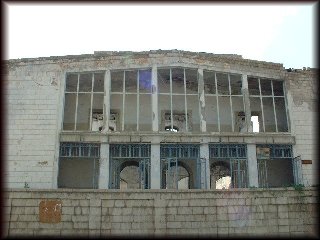 |
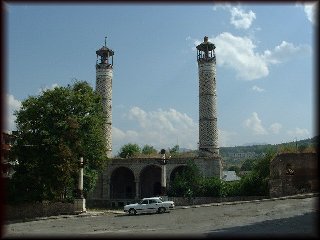 |
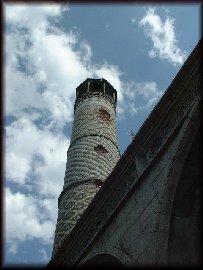 |
|
|
|
|
We passed by ruins of a mosque, whose half destroyed minaret remains blueishly beautiful, even in its ruined state. I wanted to snap a picture but the Minister said "Don't bother, it's an Azeri mosque...not interesting. Let's see the Persian mosque instead." There it is – a beautiful turquoise structure with two minarets. The exterior has been restored although the interior was totally devastated by the fighting. "This was a great Persian Silk Road town and the Iranians have always been our friends," said the Minister. Yes, the geopolitical situation in the Caucasus have led to a strange web of allied relationships. Turkey, with their ethnic cousins, Azerbaijan; Armenia with their Orthodox cousins, Russia; Armenia with Iran (!) - Armenia is Iran's link to Georgia and Europe and Iran is Armenia against Turkey and Azerbaijan, not to mention Iran's fear of Azerbaijan's claims on Iran's 20 million ethnic Azeri citizens. Another unusual phenomena - the Iranians trade as middlemen between Azerbaijan and Armenia - the famous Azeri tea, Azercay, can be found in the shops of NKR, specially brought over by the Iranians from Baku. (Onnik say these were brought over from Georgia rather than Iran.) Russia sided with the Azeris at the beginning of the war (while shooting Azeris on the streets of Baku), then changed sides to supply the Armenians with weaponry. The US Senate, charmed by the Armenian lobby, passed laws to impose sanctions on Azerbaijan, and yet airlifted Afghan Mujahideen to the frontline, perhaps to help US oil companies secure some Azeri concessions. Well, in the real world, it’s national interests that ultimately count.
We also visited Shushi Cathedral where the priest (or abbot?) welcomed us, and brought us to an underground chapel beneath the altar where we experienced its extraordinary ascoutic effects - I felt as though I was singing with a microphone there! Before we left, the abbot gave me two bottles of NK wines as a present - they have been blessed by the Bishop of Karabakh, he said.
The Minister drove me to his office in the central Government Building where I checked my emails. I sent this email which showed how excited I was:
Sent: 27 August 2000 13:45
Subject: [twc-nomad] Greetings from the office of the Minister of Statistics
of a rebel republic
Dear All,
After a 6 hour car ride (during which the driver and another passenger
all invited me to stay at their place for free - amazing hospitality from
these Karabakh Armenians), I have finally arrived in Stepanakert, capital
of the breakaway Republic of Nagorno Karabakh. NKR, largely inhabited
by Armenians, broke away from Azerbaijan in 1989, sparking off a bitter
war which lasted till 1994. This territory is still recognised internationally
as Azeribaijan territory but is effectively independent.
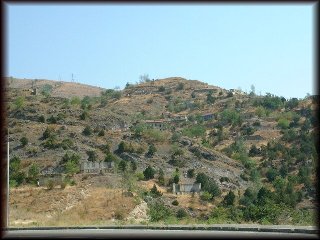 |
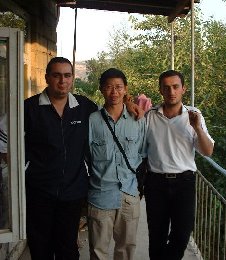 |
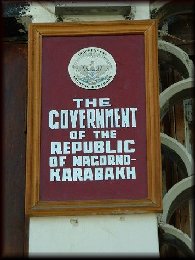 |
|
|
|
|
H., a young Armenian working in a Karabakh ministry, was supposed to meet me but he couldn't be contacted. Instead his flat mate, together with his boss, the Minister, drove me around this mini state. I'm now in the Minister's office, using his email... first time I ever have a government minister driving me around, and even using his computer... anyway, just to say hi to you guys... would report more about this exciting visit to a rebel state later, when I get back to Yerevan tomorrow evening.
Take care !
Wee Cheng
Stepanakert
Nagorno Karabakh Republic
----
The Government Building - this was not far from where NKR President Arkady Ghukassian was attacked by assassins in March this year and survived. NKR's Defence Minister was subsequently arrested and would soon be put on trial. This is but one of the many political acts of violence in NK and Armenia. In 1992, NKR's first head of state was assassinated and in Oct 99, Armenia's Prime Minister and Speaker of Parliament were gunned down along with other ministers. A few hours before, in Shushi, we passed workmen busily building a monument to the assassinated Armenian PM Sarkissian, who was largely credited for the liberation of NKR.
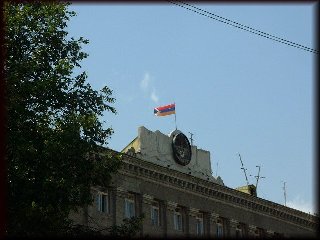
Parliament of NKR - the flag represents the desire to unite with
Armenia
If Naxcivan was the birthplace of Azeri leaders, Karabakh does look as if it may well play the same role for Armenia. Robert Kocharyan, native of Karabakh, graduate of Yerevan Polytechnic Institute, came into prominence in the War. One of the early champions of the cause, he became the first elected President of the NKR and was later asked to become PM of Armenia by Ter-Petrosyan, the first Armenian President. Once in power, the table was turned around by Sarkissian – the real power behind the throne, who forced the resignation of Ter-Petrosyan, and Kocharyan was elected President of Armenia. Wait a minute, some Armenians argued, Kocharyan wasn’t a citizen of Armenia… wasn’t him a Karabakhi and technically a citizen of Azerbaijan… Anyway, by that time, Kocharyan has already gained power and such arguments can’t stick. But one never quite know what to expect in the murky waters of Caucasus politics. Kocharyan’s power was only as secure as no one else was as powerful. Hence the conspiratorial theory that alleged that Kocharyan had something to do with the assassination of Sarkissian, arguably the most powerful man in Armenia since he controlled the Army.
We managed to contact H. and parted with the Minister. It was
a pity I was on such a short visit to NK. Otherwise I would have
been able to visit Agdam, an Azeri city totally destroyed by the Armenians.
I was too polite to ask the Minister to bring me there. And of course,
I did not ask him about the 1 million Azeris now languishing in refugee
camps (although the Armenians I met seemed only concerned about the 300,000
Armenians expelled from Azerbaijan), nor about the civilian war dead in
this war – atrocities committed by both the Armenian (especially the famous
Khojaly incident) and Azeri forces. In conflicts, it's always better
to be on the victor's side. The problem is that in the long run,
it's sometimes difficult to distinguish between the victors and the losers.
An imposed peace tends to be mere temporary and will only lead to another
war.
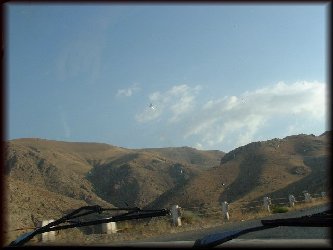 |
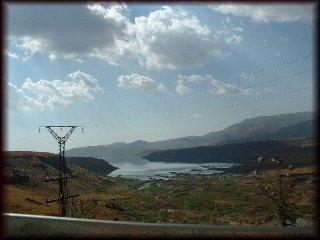 |
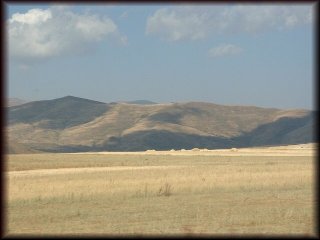 |
|
|
28 August 2000 Stepanakert - Yerevan
I sent this email from Yerevan:
Sent: 29 August 2000 17:49
Subject: [twc-nomad] Limping from Karabakh to Yerevan on a Flat Engine
Barev!
(Hello in Armenian)
Wooof ! 35'C I'm finally back from beautiful (though still scarred by the wounds of war) Karabakh after a 9 hour mashrut (mini-bus) ride - the journey was supposed to last 5 1/2 hours but the mashrut had a plague of problems - ranging from flat tire to failing engine... there were times I was so worried that it may fail to brake and fall into the many abyss and gorges that we encountered on the way back north to Yerevan. And this excluded the numerous police checkpoints along the way – every stop meant that driver had to pay additional bribes…no wonder he cursed and swore after every stop. I was seated next to the driver, and was almost roasted to death by the tortuous heat - 3 years of living in the UK have made the tropical creature in me a softie to heat...
Back to Yerevan, I got in touch with Onnik and his wife Gohar, and we
met first in a cafe, and then a great Armenian restaurant with live Armenian
song and dance. Onnik is a British photo-journalist of Armenian ancestry
who's now living in Yerevan writing for various news agency and helping
to promote tourism in Armenia. I had a great time with him and his
wife, discussing various issues ranging from Kurdistan to Armenian coffee.
The food was also great, and ambience fantastic - and guess what - the
bill for 3 persons came up to 5,000 Drams, or US$10.
![]() 29 August Yerevan, Lake Sevan and Dilijan
29 August Yerevan, Lake Sevan and Dilijan
Want To Bring An Armenian Cross Home
?